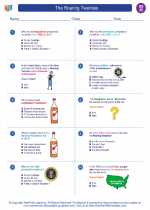LGBTQ+ Study Guide
What is LGBTQ+?
LGBTQ+ stands for lesbian, gay, bisexual, transgender, queer, and others. The "+" represents other sexual orientations and gender identities that are not included in the initialism.
History of LGBTQ+ Rights
The LGBTQ+ rights movement has its roots in the late 19th century and has evolved significantly over time. Major events such as the Stonewall Riots in 1969 and the legalization of same-sex marriage in various countries have marked significant milestones in the fight for equality.
Discrimination and Challenges Faced by LGBTQ+ Community
Members of the LGBTQ+ community have historically faced discrimination, prejudice, and violence. Many have also struggled with coming out and being accepted by their families, communities, and societies at large.
Impact on Society
The LGBTQ+ community has made significant contributions to various fields including arts, literature, science, and politics. Additionally, their fight for equality has led to changes in laws and policies that benefit not only LGBTQ+ individuals but all members of society.
Resources for LGBTQ+ Individuals
There are numerous organizations and support groups available to provide assistance and resources to LGBTQ+ individuals. These include counseling services, legal support, and community centers that offer a safe space for LGBTQ+ individuals to connect and receive support.
Challenges in Education
Educational institutions continue to face challenges in providing a safe and inclusive environment for LGBTQ+ students. Issues such as bullying, lack of representation in curriculum, and barriers to accessing resources and support are areas that need to be addressed.
Conclusion
The LGBTQ+ community has made significant strides in the fight for equality, but there is still much work to be done. Education, awareness, and advocacy are key components in creating a more inclusive and accepting society for all individuals, regardless of their sexual orientation or gender identity.
.◂Social Studies Worksheets and Study Guides Eighth Grade. The Roaring Twenties

 Worksheet/Answer key
Worksheet/Answer key
 Worksheet/Answer key
Worksheet/Answer key
 Worksheet/Answer key
Worksheet/Answer key
